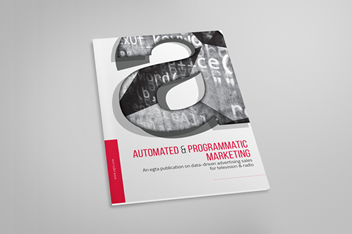 This week’s egtabite features VideoRange, the programmatic trading platform for online video inventory launched by MTGx in April 2015. This week’s egtabite features VideoRange, the programmatic trading platform for online video inventory launched by MTGx in April 2015.
VideoRange – one of the first services of its kind to be implemented in Europe – allows automated buying of video inventory on MTG’s advertising-supported VOD services in Sweden, Norway and Denmark, and it will be extended to the broadcaster’s A-VOD services in the Baltic countries, Bulgaria and the Czech Republic. 15% of all online video adspend is expected to be programmatic in 2015, and this is forecast to reach 36% in MTG’s European A-VOD markets in 2020.
LiveRail’s Supply Side Platform (SSP) is the technology driving the platform, and MTG will implement a market leading Data Management Platform (DMP) later in 2015 that will allow the broadcaster’s first-party data to be leveraged and both generic and custom-built audience segments to be created.
The following interview with Alexander Bastin, Head of Digital Trading at MTGx, is part of a wider conversation that can be found in egta’s recently published report on automated and programmatic marketing. Please contact the egta team for details on how to order copies of this book.

egta: As a publisher, what do you see as the key reasons for introducing a programmatic model?
 Alexander Bastin (AB): Firstly, realising the value of the user data that the publisher owns. With all the traffic we have, on several different platforms and services, we have a lot of user data that we have until now not leveraged in a smart way, and I think many publishers are in the same situation. Realising and leveraging the value of this user data in order to increase advertiser value, and by that also CPM levels, is a clear upside in programmatic. Alexander Bastin (AB): Firstly, realising the value of the user data that the publisher owns. With all the traffic we have, on several different platforms and services, we have a lot of user data that we have until now not leveraged in a smart way, and I think many publishers are in the same situation. Realising and leveraging the value of this user data in order to increase advertiser value, and by that also CPM levels, is a clear upside in programmatic.
Secondly, inventory optimisation. Programmatic enables publishers to better optimise inventory and work smarter with yield management. When you do real-time sales through multiple sales models, you can more easily maximise the efficiency of the impressions you’re playing out. It’s about streamlining the inventory to get the most value out of every single potential impression.
Also, if nothing else it is simply about catering to demand. The market is developing and we experience a growing demand from the buy side for programmatic inventory, and we always want to deliver the best online video product to our clients, so this is something we want to be able to offer.
egta: What programmatic models will be employed within VideoRange?
AB: We are looking to enable both programmatic direct and invite-only auctions. We see that our clients still want to be able to buy guaranteed impressions, although now programmatically, but also want to complement that with the flexibility of an auction-based integration. The auction-based part is for me the core of programmatic; that can really exploit the upside of adding user data to the impressions.
egta: One of the arguments that we have heard from publishers is fear of declining CPMs and actual revenues. But I take it that you see a net benefit as a result of programmatic rather than a net deficit?
AB: Programmatic for me as a concept does not in any way imply eroding CPM levels. Rather, it is more about making our video inventory easier to buy, exposing it better to the market and maybe in the process also exposing it to more buyers than before. I think the fear of eroding CPM levels comes from the display side, where the market situation is completely different with supply being much greater than demand. The situation for premium online video is often quite the opposite, and so far we are actually seeing CPM levels being higher on the programmatic side. The challenge for us is to continuously show and prove our position as a premium video player, differentiating MTG from the non-premium inventory available in the market.
egta: What would you see as the main success factors for broadcasters looking to introduce programmatic trading?
AB: Having a sales strategy that incorporates programmatic sales, having the necessary skills and resources in place to streamline the workflow, and doing as much as you can yourself to cut out as many as possible of the increasing number of middlemen taking a “technology tax” in the value chain.
egta: Could you identify any potential pitfalls that should be avoided by broadcasters exploring programmatic selling?
AB: Keeping the premium differentiation and not viewing programmatic as a way to monetise remnant inventory at discounted rates is fundamental to not erode inventory value. All publishers should also avoid doing deals that enable an arbitrage model, where transparency in the value chain is interrupted somewhere between the publisher and the advertiser. If a publisher does a deal with a middleman rather than the endpoint advertiser, the publisher loses control of the actual end value of the inventory and thus also loses insight into for example what inventory has what value to what advertiser or vertical.
egta: Whilst you are not doing it right now, would you like to see programmatic come to linear TV, or do you believe that the existing model is better for that inventory?
AB: I would definitely want to see it on the linear side as well. Programmatic is at the core about automation and targeting, which increases impression efficiency for both the buy side and the sell side. |




